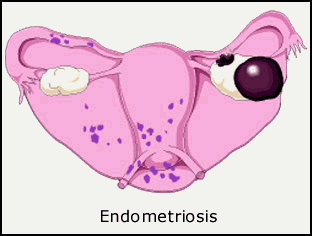Many women suffer from endometriosis. This is a condition where tissue that normally lines the inside of your uterus, grows outside your uterus. It can be a painful condition and even cause infertility. An endometrioma or endometrioma cyst on the ovary can occur because of this condition. These cysts are significantly more painful that a common ovarian cyst and can be complicated to manage. They are most prominent during the reproductive years and largely related to reproductive hormones.
This article will help you understand more about endometriomas and how to deal with them.

What Is Ovarian Endometrioma?
Ovarian cysts are actually pretty normal for most women. An endometrioma cyst is a more complicated cyst that can cause chronic painful periods. Endometrioma is actually a type of endometriosis. About 17 to 44% of women in their reproductive years that suffer from endometriosis are affected with endometriomas, aka ‘chocolate cysts.’ The cysts are filled with a brownish fluid that is made up of blood from the endometrial tissue.
Endometrioma cysts come from the endometrial lining growing outside of the uterus and onto the ovaries. The build-up of this tissue causes cysts. The condition gets worse with changes in hormones around the menstrual cycles. The cysts can grow into the ovaries and actually replace regular ovarian tissue. As the cysts spread, inflammation and pain develops in the pelvic region.
While regular cysts are quite normal for most women, about 5 to 10% of women suffer from chocolate cysts. Overall, millions of girls and women suffer from endometriomas. They are most common during reproductive years and they are also more common on the left ovary. The cysts occur over and over and can grow to the size of a softball.
Ovarian Endometrioma Symptoms
The symptoms of an endometrioma are mostly the same as with a regular ovarian cyst, just more exaggerated. The common symptoms with this type of cysts include:
Cramping in the abdomen and pelvis
Painful periods that get worse over time
Pain in the pelvis when urinating or having a bowel movement
Pain in the pelvis with exercise, stretching, or bending over
If the ovary twists, losing its blood supply, you may feel very intense pain
Severe pain with rupture of the cyst
Fever and vomiting with rupture
Spotting or bleeding between periods
Discharge that is dark in color
If you have severe sudden pain in your pelvis, seek immediate medical attention. A ruptured ovarian cyst or ovarian twisting are medical emergencies.
How Does Ovarian Endometrioma Affect Fertility?
Endometriosis that grows on the ovary and forms endometrioma cysts can prevent the ovary from forming eggs that are able to be fertilized. Eggs may be released from the ovary, but sperm cannot penetrate the walls of these eggs.
The fallopian tubes may develop scarring due to endometriosis and this interferes with transport of the egg and sperm. It may also lead to a higher risk of tubal (ectopic) pregnancy. There may also be other substances present that prevent fertilization of the egg.
Since endometriosis is affected by the reproductive hormones, there may be disruption in their balance. This can prevent a fertilized egg from implanting into the uterine wall and cause miscarriage.
Incidence of infertility due to endometrioma is most common in women aged 25 to 40 years of age. The earlier treatment is started, the better the chances of having a baby. Many women with endometrioma are able to have successful pregnancies with in vitro fertilization (IVF).
Ovarian Endometrioma Treatments
Medications
If you have symptoms of an endometrioma cysts, your doctor will most likely give you medications to calm down the endometriosis. These include:
Non-steroidal anti-inflammatory drugs (NSAIDs) to reduce inflammation
Gonadotropin Releasing Hormone Analogs (GnRH Analogs) to suppress estrogen
Birth Control Pills to suppresses hormone levels that increase endometrial growth
Androgens (Danazol) that lowers estrogen and shrinks excess endometrial tissue
Aromatase Inhibitors (Femara) which disrupts estrogen production
Surgical Intervention
If you have a severe problem with endometrioma the doctor may need to surgically remove the ovary (oophorectomy). This is usually not done during the reproductive years because of increase infertility.
Less than one percent of all ovarian cysts are cancerous, but there is slight chance. If an endometrioma is over 4 centimeters, surgery must be performed to biopsy for malignancy. Surgery is also indicated if pelvic pain is chronic and severe.
Most doctors opt to watch and wait and try medications first. If this method does not relieve pain and symptoms, doctors may try to just surgically remove only the cyst. This can actually help increase fertility and give long-term pain relief to younger women who wish to try and have children. This procedure can raise the chances of pregnancy by 50 percent in the first few years after surgery.
Risks of Surgeries
The only time that surgical removal of endometrioma cysts is not indicated is when women plan to use In Vitro Fertilization (IVF). This method of treatment actually lowers the egg production from the ovary and IVF requires maximum egg production for egg retrieval. However, your doctor may still choose to remove the endometrioma before IVF in the following situations:
Possible malignancy (cancer)
Pain with drugs used to stimulate egg production
The endometrioma ruptures or becomes infected
Even with the risks on fertility, surgical intervention is still the main treatment used to relieve symptoms successfully. The risks of surgery include ovarian damage, rupture of cysts or ovary, increased infertility, increased pain, hemorrhage, and infection. These surgeries have fewer risks if attention is paid to when the surgery is performed and by using a very conservative surgical technique. If you decide to have this surgery, ask your doctor about going to a specialty center that deals specifically with endometrioma surgery.

View All Comments /Add Comment